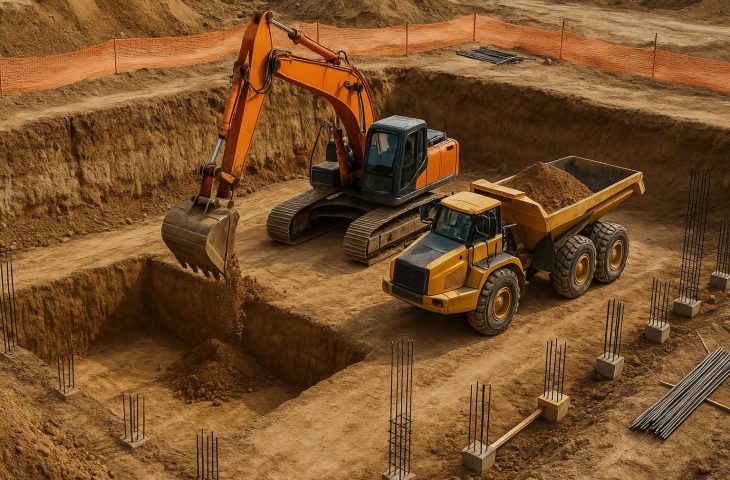Carl Immich: The Foundation Excavation Process
by ago0

Carl Immich, a seasoned builder and craftsman based in Rensselaer, New York, brings decades of experience to his work as owner and operator of Builders Choice. His company specializes in custom home construction, renovations, and property management, combining high-quality materials with attention to safety, precision, and lasting craftsmanship. Before launching Builders Choice in 2018, Mr. Immich built a successful career in boat and yacht design, home additions, and foundation work, developing expertise in electrical systems, excavation, and land maintenance. Known for overseeing projects from design to completion, he ensures that every phase meets structural and aesthetic standards. Drawing from his extensive construction background, Carl Immich provides insight into the foundation excavation process—one of the most crucial steps in creating stable, long-lasting homes and buildings.
The Foundation Excavation Process
Excavation is one of the most critical phases of construction as it lays the groundwork for a stable and long-lasting foundation. Done improperly, excavation can lead to structural instability, water damage, or costly repairs. Below are the key steps involved in foundation excavation, from site assessment to final inspection.
Starting with site assessment, the contractor will evaluate the site where the excavation will occur to understand the soil conditions and topography. This enables them to figure out the bearing capacity of the soil and settle on the right type of foundation for it. The contractor will also take note of water table levels, the site’s proximity to surrounding structures, and obstacles present on the site and underneath (utility pipes). This knowledge will guide them in planning the excavation.
After the preliminary assessment, the contractor will advise the developer on the permits necessary for the excavation. This way, the owner can seek out the permits from local authorities and environmental agencies while the contractor is designing and planning the excavation.
In the design and planning stage, the contractor will prepare a plan for the excavation and assemble a team of trained excavation professionals for the job. The contractor then assembles the equipment necessary for excavation, from excavators and backhoes to hand tools such as shovels and pickaxes. They also provide safety gear for workers, such as hard hats, gloves, and steel-toed boots.
Once the plan is in place, the team is ready, and permits are secured, excavation begins. The process starts with clearing the site. Construction workers remove vegetation, rocks, debris, and any existing structures from the site. They then level it. Next, a licensed surveyor marks out the building’s layout on the ground using stakes and string lines, based on the architectural and structural plans. These markings delineate the boundaries of the site, ensuring excavation aligns with building plans.
Actual excavation follows. Construction workers dig the soil from the site using heavy machinery or manual tools, depending on the project’s requirements. They excavate uniformly across the site, level by level, until they reach the desired depth of the building. As the team excavates, they typically have de-watering pumps on hand to remove excess groundwater. This is important as excess moisture will lead to soil erosion and cause instability.
Once the team is done excavating, the contractor will inspect the excavation to confirm it meets the building plan’s specifications. Typically, the taller the building, the deeper the foundation it will require. If the depth and width of the foundation meet the plan, the contractor will then evaluate the underlying soil for compaction.
Compacted soil is more tightly packed, providing a stable base for the foundation. If the soil is not adequately compacted, the contractor will move a roller across the excavation base to level and compact it. For deep excavations, the sides need to be sloped back or supported with shoring systems to prevent cave-ins and protect workers. Only when inspectors have assessed and approved the excavation should work begin on building the foundation.
Several factors affect how long excavation takes. They include project size (larger sites need more excavation), soil conditions (rocky soil requires more time than sandy soil), and weather conditions (rain and snow complicate the process). The time it takes to acquire permits and the type of equipment a contractor uses also play a role. Generally, though, it takes three to five days to finish the excavation for a single-family home and three to six weeks for a commercial building. Excavation work for high-rise constructions can take several months.
It is possible to make excavation more efficient, hence less time-consuming. Contractors can do this by doing more comprehensive site evaluations to identify challenges early, using skilled workers and modern equipment, monitoring the weather to minimize delays, and facilitating effective communication across teams for better alignment.
About Carl Immich
Carl Immich is the owner and operator of Builders Choice, a custom home construction company based in Rensselaer, New York. With a background spanning boat design, residential renovation, and land development, he oversees every stage of construction from planning to completion. Mr. Immich has experience in foundation work, electrical and plumbing systems, and property inspections. Before founding Builders Choice, he worked with Monterey Boat Builders and American Custom Yachts. Outside of work, he enjoys skiing, fishing, archery, and competing in Spartan Races.



